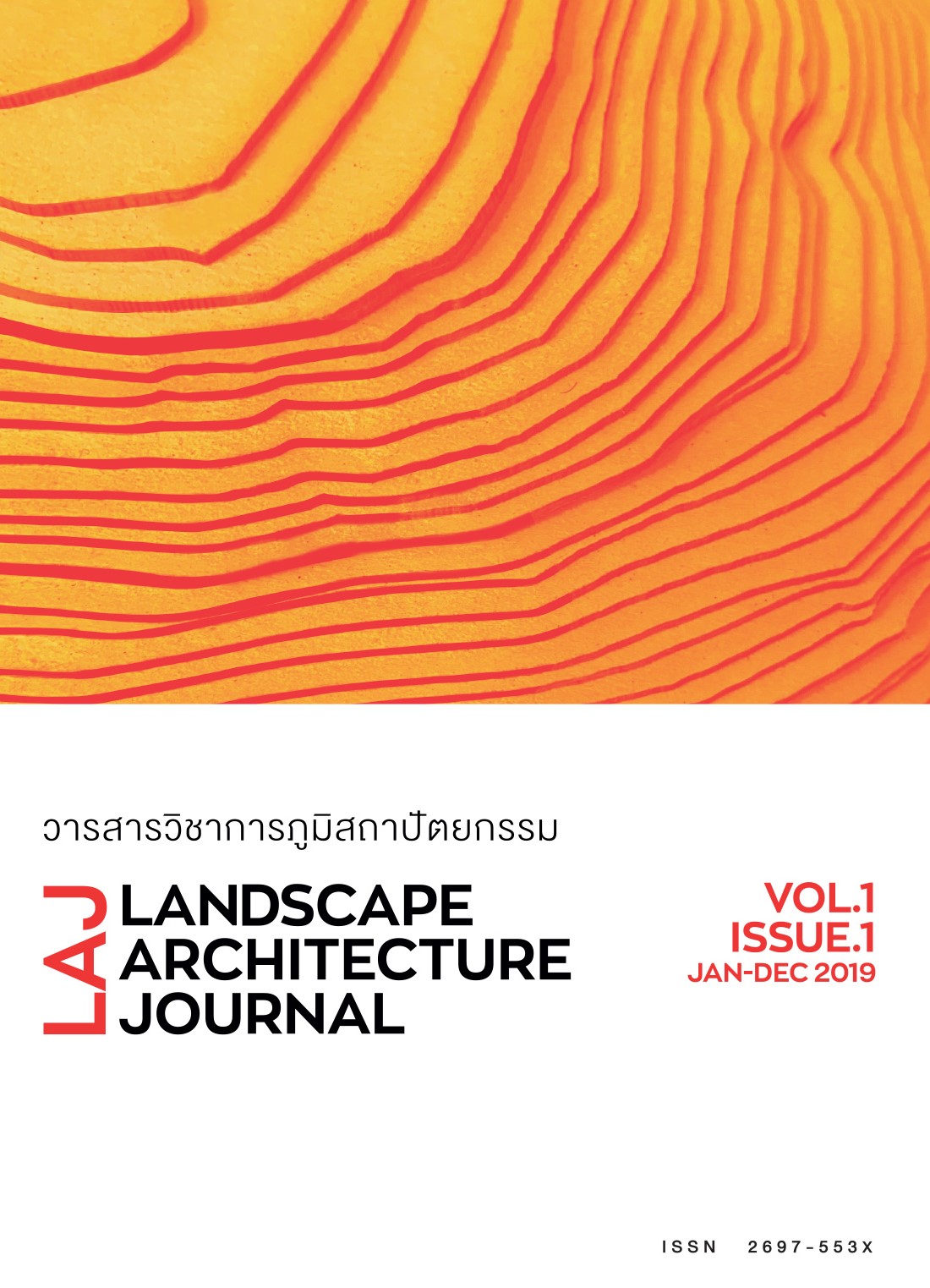Conceptualisations and Expectations for the Landscape of a Place Designed for Enhancing the Elderly Well-being in the Municipal Context: a Case Study of the Elderly Centre, Saensuk Municupality, Chonburi Province
Main Article Content
Abstract
Gathering research data in parallel with working on a design project, the research aims to gain insight into the needs, expectations, opinions, experiences as well as behaviours of the elderly and other stakeholders who involved in the design process and will be the users of outdoor spaces in an elderly centre which is operated by a local government of a municipality. In the case of Saensuk Elderly Centre, as part of the designer team, who applied the participatory design process for
the project, the researchers conducted participant observation as the main method for the data collection process, additionally relevant evidence in different forms was gathered. By using thematic analysis method, the data were scrutinised and analysed into themes. Theories related to the issues of place and identity were applied as the main conceptual framework. The results show that both the elderly and the local personnel shared a dream of a place that can show certain local characteristics and respond to their needs. A sense of belonging was also expressed. Furthermore, expectations and concerns are considered as a common issue reflected by participants in different groups. The findings underline the importance of the design consideration emerged from particular local contexts which should be elaborately blended together with the standard guideline for age-friendly design when designing a public open space for the older people.
Article Details
References
เทศบาลเมืองแสนสุุข. (2562). สถิติจำนวนประชากร เทศบาลเมืองแสนสุข ปี พ.ศ. 2543-2562. สืบค้นจาก https://www.saensukcity.go.th/news/population-statistics.html
ธนาศรี สัมพันธารักษ์ เพ็ชรยิ้ม, สุุปรียา หวังพัชรพล, ขวัญชัย กาแก้ว, และสุพิชญา ศุภพิพัฒน์. (2560). สุขตามวัย: สิ่งแวดล้อมสรรค์สร้างที่เป็นมิตรกับผู้สูงอายุ. กรุงเทพฯ: กลุ่มวิจัยสิ่งแวดล้อมสรรค์สร้างเพื่อสุขภาวะ.
Atkinson, P., Coffey, A, Delamont, S., Lofland, J, and Lofland, L. (eds.). (2001). Handbook of Ethnography. London: SAGE.
Bernardo, F. and Palma-Oliveira, J.M. (2012). ‘Place Identity: a central concept in understanding intergroup relationships in the urban context’ in Casakin, H. and Bernardo, F.. The Role of Place Identity in the Perception, Understanding, and Design of Built Environments. Bentham Science, 35-46, DOI:10.2174/97816080541381120101.
Bonaiuto, M., Breakwell, G., and Cano, I. (1996). ‘Identity process and environmental threat: the effects of nationalism and local Identity upon perception of beach pollution’. Journal of Community & Applied Social psychology, 6, 157-175.
Carmona, M., Tiesdell, S., Heath, T., and Oc, T. (2010). Public Places-Urban Spaces. 2nd edition. Italy: Architectural Press.
Flick, U. (2009). An Introduction to Qualitative Research. 4th edition. Great Britain: Sage Publishing Ltd.
Gesler, W. (1992) ‘Therapeutic Landscape: medical issues in light of the new cultural geography’. Social Sci. Med., 34(7), 735-746.
Gustafson, P. (2001). ‘Meaning of Place: everyday experience and theoretical conceptualisation’. Journal of Environment Psychology, 21, 5-16.
Kearns, R. and Gesler, W. (1998). Putting Health into Place: Landscape, Identity, and Wellbeing. USA: Syracuse University Press.
Korpela, K. (1989). ‘Place-Identity as a product of environmental self-regulation’. Journal of Environmental Psychology, 9, 241-256.
Parker, G. and Doak, J. (2012). Key Concepts in Planning. SAGE Publication.
Proshansky, H. M., Fabian, A. K., & Kaminoff, R. (1983). Place-Identity: Physical world socialization of the self. Journal of Environmental Psychology, 3(1), 57-83.
Relph, E. (1976). Place and Placelessness. London: Pion Limited.
Relph, E. (2007). Spirit of Place and Sense of Place in Virtual Realities. Technè, 10(3), 17-25.
Sanders, Elizabeth B-N., and Pieter J.S. (2008). Co-creation and the new landscapes of design. Co-design, 4(1), 5-18.
Sanoff, H. (2007). Editorial: Special issue on participatory design. Design Studies, 28(3), 213-215.
Sime, J.D. (1986). ‘Creating Places or designing spaces?’. Journal of Environmental Psychology, 6, 49-63.
Sinuraibhan, S., Petyim, T. S., Ramasoot, S., Wungpatcharapon, S., Kakaew, K., & Mallikamarl, P. (2016). Negotiation in Design: The Participatory Process in Designing Healthcare Facilities of a Public Hospital. JARS, 13(2), 85-97.
Tuan, Y. (1975). ‘Place: an experiential perspective’. American Geographical Society, 65(2), 151-165.
Ulrich, R. (1999). ‘Effects of Gardens on Health Outcomes: theory and research’ in Marcus, C.C. and Barnes, M. (eds.). Healing Gardens, 27-86.
Wall, E., and Waterman, T. (2010). Urban Design. Singapore: AVA Publishing SA.
White, D., Virden, R., and van Ripe, C. (2008). ‘Effects of Place Identity, Place dependence, and experiences-use history on perceptions of recreation impacts in a natural setting’. Environmental Management, 42, 647-567.
WHO, Regional Office for Europe. (1986). “Ottawa Charter for Health Promotion”. Retrieved from http://www.euro.who.int/AboutWHO/Policy/20010827_2; 17/8/2005.
Williams, A. (1998). ‘Therapeutic Landscape in Holistic Medicine’. Social Sci. Med., 46(9), 1193-1203.

